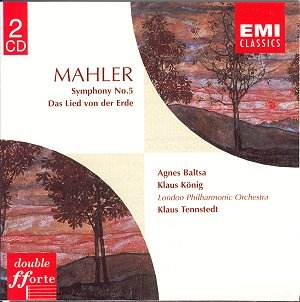This reissue of two performances by one of the great Mahler interpreters
is a major event in the recorded music world, even if it is not a new
one.
In the later part of his career, Tennstedt developed
a close relationship with the London Philharmonic Orchestra as their
principal conductor, and was noted for his Mahler performances in particular.
Their recordings together for EMI covered the complete Mahler symphonies
and made a great impression.
Tennstedt in fact issued two recordings of the Fifth
for EMI: this one from 1978 and a live recording from the Royal Festival
Hall, made some ten years later. The latter had a mixed reception, admired
for its intensity but criticised for some indulgences of tempo.
Such problems do not apply here, and full marks to
EMI for the digital remastering by Simon Gibson. The opening trumpet
fanfare is impressive indeed, not least for the way in which the crescendo
builds until the orchestra follows the fanfare with the utmost force.
The lamenting strings of the funeral march are the natural foil to this
immediate expressionist crisis, ensuring that the contrasting sections
develop with all the required tumult and anguish.
The second movement, marked 'With the utmost vehemence',
continues the insistence of this intensity, as it must, until in the
later stages Tennstedt releases a foretaste of what will be the clinching
final chorale. The ebb and flow of tension and relaxation are particularly
well handled in this movement.
The central Scherzo has a tempo which lets the rhythm
make its emphasis, just as Mahler insisted it should. The LPO horns,
and the orchestra in general, are at their virtuoso best here, and the
percussionists add their contributions most effectively. In the final
climax of the coda the sound becomes somewhat congested, revealing perhaps
that this is a remastering of a twenty-year-old recording. To be fair,
Mahler's orchestration does not exactly make things easy for the recording
engineers.
The Adagietto is slow and expressively poignant, with
highly effective shadings of dynamic.. Out of this the Rondo-finale
emerges brightly, with its bouncing rhythms and lively principal theme.
Seldom can the symphonic momentum and cohesive flow of this music have
been more compellingly delivered, until the release of the full glory
of the brass chorale (with its subtle links back to movement two), bringing
the Symphony to its logical and triumphant conclusion.
This closing phase holds many challenges to conductors
and orchestras. On the obvious level of virtuosity and momentum, Tennstedt
and the LPO are magnificent, but ultimately they miss the spirituality
which comes from the balancing of the complex orchestral textures and
the phrasing of the final appearance of the brass chorale. Here, at
the special moment of judgement, as it seems to me, Barbirolli's recording
(EMI 5 66910 2) remains without peer.
Tennstedt is also a compelling interpreter of Das Lied
von der Erde. In fact the recording has had a chequered life, apparently
because the conductor was unsure about it and did not immediately sanction
its release. Listening to it now, it is hard to understand why. The
orchestral playing is top class and the singing is committed and characteristic.
The only obvious drawback, though not a damaging influence, is that
the tenor, Klaus König, sometimes seems strained in his approach.
That sense of strain, of course, is part and parcel
of a vocal style that has its roots in Beethoven's Ninth Symphony and
in Wagner. It is just that in the opening movement, Das Trinklied vom
Jammer der Erde (The Drinking Song of the Earth's Sorrow), one is more
aware of the issue than one might wish to be. But the sweep of the music,
and its ebb and flow, are wonderfully handled by Tennstedt, whose interpretation
confirms that this work is a true symphony, not an orchestral song cycle.
Agnes Baltsa is in excellent voice throughout, held
in an ideal balance with the orchestra, amid a recording ambience which
does justice to Mahler's subtle textures. For this work above all shows
the composer's fondness for using a series of chamber orchestras rather
than merely one large orchestra. Tennstedt makes the most of the myriad
opportunities for shaping this music, and the somewhat lighter inner
movements have beautifully judged balances of orchestral colour, with
the vocal line always caught in focus.
The final movement, Der Abschied (The Farewell) is
the longest, not far off half the work, some 31 minutes out of 66 minutes
in total. Maintaining the music's many tensions across that lengthy
span is of course the major challenge, but it is a challenge that Tennstedt
readily takes in his stride. And so too does Baltsa, who in my view
matches the achievement of other, more famous, interpreters, including
Kathleen Ferrier, Janet Baker and Christa Ludwig, for example.
The orchestral details captured by the excellent EMI
recording makes it sound just right for this music, since it is also
lustrous and sonorous when required.
Tennstedt's performance of Das Lied von der Erde is
on a separate disc, so the work need not necessarily have been issued
in this pairing with the Symphony No. 5. However, since they are both
excellent performances which are now available at a competitive price,
they make a most attractive proposition.
Terry Barfoot



 London Philharmonic Orchestra/Klaus Tennstedt
London Philharmonic Orchestra/Klaus Tennstedt